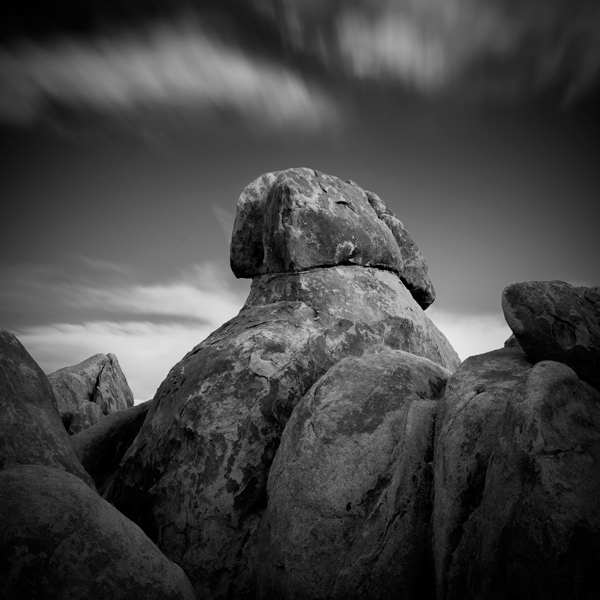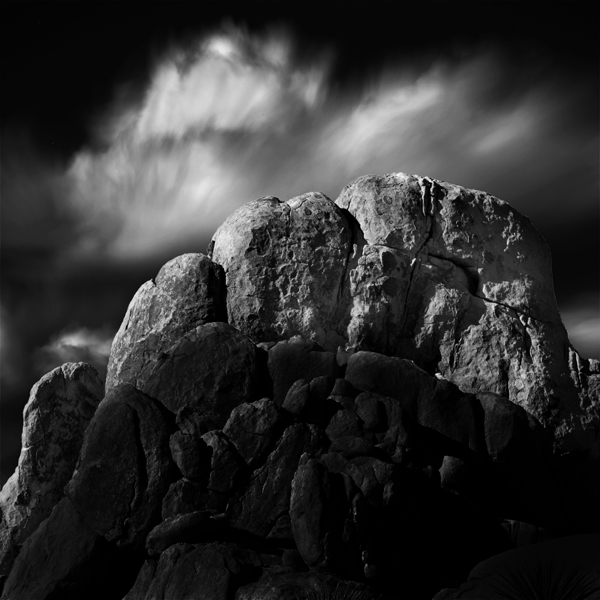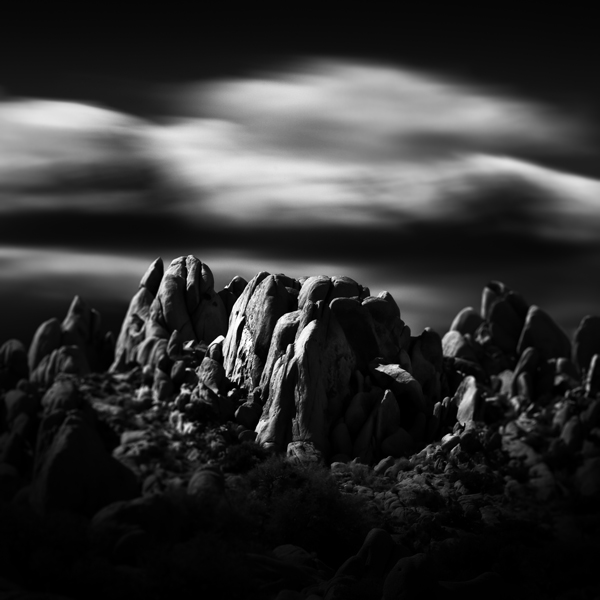Cole Thompson is a photographer based in Colorado, USA. His early inspiration comes from photographs created by Adams, Weston and Bullocks. He started photography in 1968 working with SLR and medium format cameras and developing the images in the darkroom. Self thought and fascinated with classical black and white images, Cole converted to digital in 2004. He is best known for his long exposures. Not earning his living from photographic work allows him to follow his artistic vision without any compromises. He likes working with the series of images. Some of the best known portfolios are Harbinger, The Lone Man, Monoliths, The Ghosts of Auschwitz; each of them tells a powerful story. Despite that his work has been shown in many exhibitions and published in numerous publications, he believes that the most important is how he feels about the art that he creates.
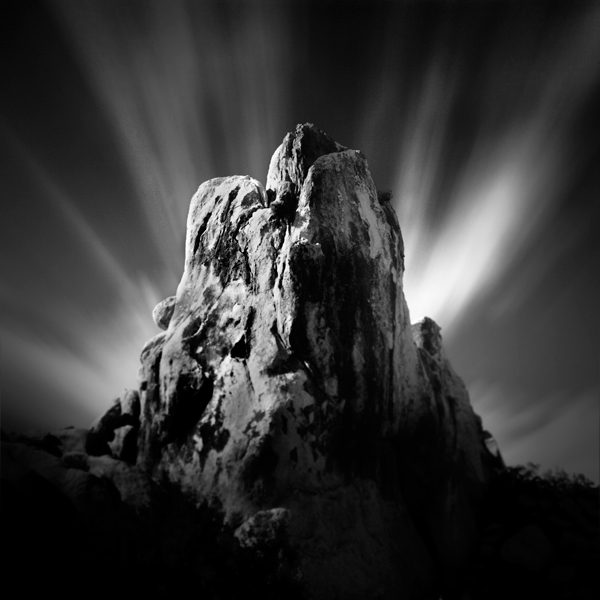
1. What was your path to become a photographer?
When I was 14 years old and living in Rochester NY (the birthplace of Kodak) I was out hiking with a friend when we stumbled upon an old house that George Eastman had once owned. This piqued my interest and I decided to read his biography.
I was fascinated by the story of modern photography and before I had finished the book, before I had ever taken a photograph or had seen an image come up in the darkroom, I knew that I was destined to be a photographer. I know that sounds unbelievable, but that's how I felt.
And so for the next ten years I immersed myself in photography. I am self-taught: I have never taken a class or workshop. I learned by reading and doing, experimenting and making mistakes.
2. Do you prefer to photograph close to home or do you find faraway places more inspiring? Are there any special places that inspire you the most to create new work?
I believe there are great images everywhere, even in our own back yards. Once I put together a slideshow of all the images I had created within a couple of miles of my home, and it was surprising as to how many there were.
But having said that, I do find that it's easier for me to see freshly when I'm in a new location. I think that's because it's easier for me to leave behind my daily routine, responsibilities and duties when I'm away from home.
But I do not need an exotic place or an iconic photo location. I can find something worthy of photographing in any location, no matter how seemingly dull or mundane.
My inspiration comes mostly when I can focus on just one thing; creating. And I find that getting away allows me to do that.
3. Are you a meticulous pre-planer or do you prefer creating images spontaneously? Do you revisit your favourite places many times to achieve the required result? Can you tell us more about your method of working?
I never plan anything other than my arrival and departure date. I do not plan a route or I do not make any hotel reservations. I do not research the sites and I do not look at any other photographers work from the area.
To be able to take this approach I must travel during the low season in order to miss the tourists and find accommodations each night.
For example I travelled to Iceland at the end of September when all the tourists had gone home. I simply drove about without plan or preconceived idea, turning left or right as my eye dictated.
I like to visit new places rather than revisit, but if I'm inspired to create a portfolio on a particular subject or place, I will return again and again until that Passion has spent itself.
For example I've been going to Death Valley every winter for years as I work on my Dunes of Nude series. I'll stop going when I tire of the series.
4. Terra Quantum displays themes and series portfolios; do you like working to the project/series/theme or find creating individual images more rewarding?
For years I only worked on creating single images and resisted working on a series. And while I created some nice images, they were all one hit wonders and my work had no cohesiveness.
And then a few years ago I decided to submit my work to LensWork. I read the submission guidelines and Brooks Jensen was very clear: do not send us your greatest hits! Send 15 or more images on the same subject or theme.
But, I said to myself, he's not seen MY greatest hits! And off they went.
Well, in very short order they returned my submission with a note that said: pick one image and send me 15 more like it! That was the kick in the pants that I needed and propelled me to create my first portfolio "Grain Silos."
I'm not sure why I had resisted for so long, but I quickly was hooked and enjoyed having a purpose and exploring a subject deeply.
Now I hate it when I complete a project and wander about aimlessly, hoping I'll see something that inspires the next one.
5. Can you tell us a bit more about your 2 chosen photographs – what is the story behind them, when/why/how they were created?
These two images are part of my “Ancient Stones” project that is still in progress. I have created most of the images in Joshua Tree, but there are other locations as well.
This portfolio shares a quality with several of my other series, such as Fountainhead, Grain Silos, Monoliths and Moai, Sitting for Portrait. I tend to think of these inanimate subjects as being alive and I relate to them as conscious beings.
And when I first saw these stones in Joshua Tree, it seemed to me that they were these ancient creatures who moved so slowly that they seemed inanimate to us. But in reality, they are alive and watching us. Smiling as they see us scramble about like ants, full of self-importance.
They sit for thousands of years, watching us and being amused.
These are two of my favorites from the series.
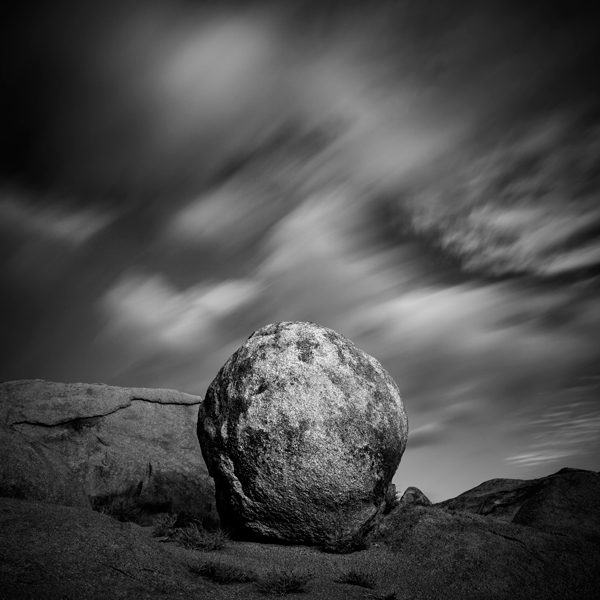
This is Ancient Stones No. 23 and it was created in the Alabama Hills in California.
I don’t believe in telling the viewer what the images mean, but rather leaving that to the viewer to decide.
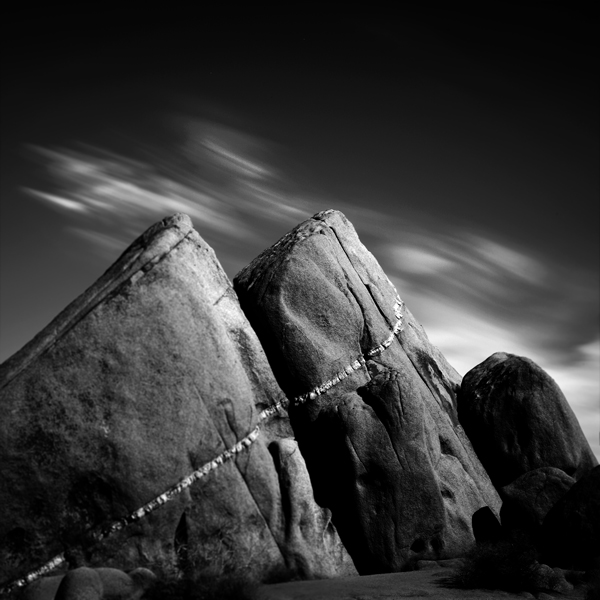
This is Ancient Stones No. 12 and this was created at Joshua Tree, in California. It is my current favorite from the series.
6. Do you find printing your images yourself as an integral part of image creation or do you use professional labs? How important is the choice of paper for you?
I feel the printing process is a part of the creative process and my job is not complete until I've printed my work and signed it.
Paper is important, but not really that important in the big scheme of things. I print on two surfaces: Hahnemuhle Photo Rag 308 and Epson Exhibition Fiber.
I'm certain there are many, many papers out there that are just as good and that I'd be equally happy with. Perhaps there are even some that might be better in some small way…but I don't believe that they would improve my work in any appreciable way. My work must stand on its own merits and while a poor paper might detract from my image, a great paper cannot take a mediocre image and make it better. Only the image can do that.
So no, I want a good paper but I am not a fanatic on a quest to find the "perfect" paper. It does not exist!
7. What are the biggest challenges nowadays for a full time photographer and how do you adjust your approach to achieve the maximum marketing potential?
I would not know, I am not a full-time photographer! I am an amateur, as defined by one who was self-taught, does not earn their living from their art and creates out of love.
I’ve always held a full time job to pay the bills and pursued my art for myself and for the love of creating. I purposely chose not to try to earn a living from my photography because I was convinced, even at the wise old age of 17, that if I photographed for a living that I’d lose my passion for it. It would become just a “job.”
I have no regrets for having made that decision. Certainly there are disadvantages to the path I chose, mainly not having enough time, but I’ve been able to retain my passion for photography.
8. Do you think that social media is killing photography or playing an important role in promoting your work? How involved are you in your online presence?
I think that social media is changing things, and who is to say if that is good or bad? But is that a good thing or a bad thing? I don’t know.
I do know that social media makes it easier for me to reach a huge audience from around the world, and that is exciting! I’ve never been a fan of the “gallery system” and so now I am master of my fate and captain of my soul. I'm glad for that.
I maintain a website, a blog and I post one image a day on Facebook, Google+, Twitter, Flickr, Instagram, Tumblr, Fotoblur and Pinterest. It takes me about 15 minutes each day to do that and my goal is to expose new people to my work and drive them to my website.
9. Do you have any plans for exhibitions, books or any interesting projects coming? Can you tell us a bit more about your artistic plans for the next couple of years?
I speak and exhibit only when invited. I currently have no book plans, but continually toss the idea around. However, I think the book market has been greatly impacted by the internet and I'm not sure what the role of photography books are in the future. Time will tell.
It is a shame because as good as an image can look on a screen, there is nothing like holding a print in your hands and admiring it. I do feel a little sorry for the current generations who have never really had that opportunity. It’s fun to see their reactions when they do see and handle a real print, it’s a revelation.
I will be speaking, exhibiting and holding a workshop in Portland this October. Plans are being made for that right how. And I do open my home gallery to the public for the Fort Collins Studio Tour this June 24, 25 and 26.
I’ve recently completed my Dunes of Nude series and have submitted that to LensWork, a publication that I respect and admire. They just recently published my “Moai, Sitting for Portrait” series from Easter Island and I'm always so pleased to have my work reproduced there. They do such fine printing, it’s actually better than most photo books that I’ve seen!
So what photo project is next? I generally do not know until it presents itself to me, and that usually happens in a moment of inspiration. I do have one project that I’ve been thinking about for years, but those usually go nowhere for me. The ones I’ve pursued to date are those that just grab me and say: GO FOR IT!
I am working on a long term project entitled “Isolated” and I’ll continue to work on that as images present themselves to me.
10. We are living on the most beautiful planet, yet it is over-burdened and over-polluted. As photography is an influential medium, do you use the power of your photographs to promote our Earth appreciation and environmental awareness? Any thoughts how photographers in general can become more involved in this important matter?
No, I guess I fall into the Ansel Adams camp on this issue. I admire those who use their art to influence others for causes they feel strongly about, but that is not me. I do not want to politicize my or try to influence others with it.
My job as an artist, as I see it, is to create images that I love. With that, my job is complete. What others think of my images is none of my business. And what my images mean, well I think that is best left to the viewer to decide.
More on his website
